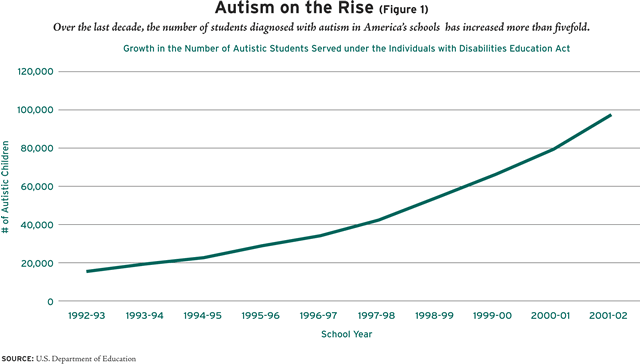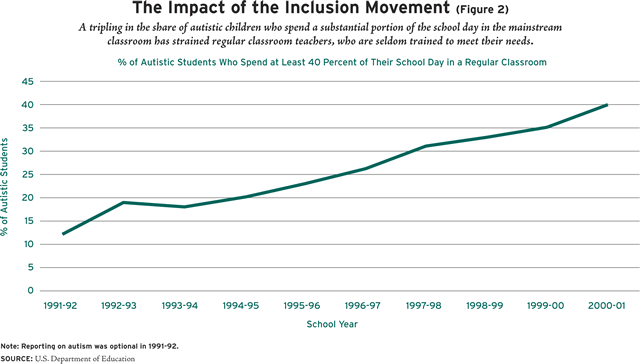Daniel walks into his kindergarten classroom and drops his outerwear, backpack, and bus harness in a tangled heap in the middle of the floor. Daniel has a singular focus this morning: building a bridge and a house out of Lincoln Logs.
He does not notice as classmates step around or over him as he plays on the hard floor. If other children move into his space, he pushes them away. One or two children greet him, but he does not answer. Daniel keeps up a running dialogue as he plays, in jargon rarely understandable to anyone but himself.
Daniel’s educational aide approaches him and, using a handmade schedule book with symbolic pictures, shows Daniel that this is not the time for playing. The first picture on the schedule is a locker, indicating that Daniel is to hang up his coat and backpack. Transitions to new activities are very difficult for Daniel, and he begins to scream and kick. Other children watch quietly or walk away.
Daniel is autistic. He is charming, intelligent, creative, and full of energy, just like his 18 classmates. However, he is unable to use language to interact with others. His rare attempts at communication are through imitation and usually in only one or two words. Teachers and aides communicate with Daniel using a combination of picture symbols and words, since children with autism learn best visually. Like other children with autism, Daniel would not understand the activities of the day without his schedule book. When events change and the day does not correspond to his schedule, Daniel may lose control and throw a tantrum. He requires the support of an educational assistant every minute of the school day.
In the past–indeed, less than ten years ago–children like Daniel were rarely placed in mainstream classrooms to learn alongside their nondisabled peers. Children with autism and other severe disabilities were more likely to be found in separate classrooms with other children with disabilities, if not in a different school altogether. Daniel’s presence in a regular classroom, with the help of an educational aide, is the result of the “inclusion” movement among advocates for the disabled. The idea behind inclusion is that every child should be an equally valued member of the school culture. Children with disabilities benefit from learning in a regular classroom, while their peers benefit from being exposed to children with a diversity of talents and temperaments.
As a result of evolving legislation and educational initiatives, today more than 95 percent of students with physical, emotional, learning, cognitive, visual, and hearing disabilities receive some or all of their education in regular classrooms. As of 2000-01, the most recent year for which data are available, 47 percent of students with disabilities spent at least 80 percent of their school day in the general-education classroom, up from 31 percent in 1988-89.
These numbers have even greater significance for students with autism. Autism is the fastest-growing disability in the country. U.S. Department of Education statistics show the number of children diagnosed with autism being served under the Individuals with Disabilities Education Act growing more than fivefold during the 1990s (see Figure 1). The California Department of Developmental Services estimates that the number of diagnosed cases in that state grew 273 percent during the 1990s.

What accounts for the increase in autism? No one knows. In the past, autism was considered an extremely rare condition. Children and adults who demonstrated characteristics similar to what we now call autism were often labeled as emotionally or behaviorally disturbed, or cognitively disabled. Most lived in institutions when they became too difficult to manage at home. Many factors are cited for the increase in autism, including better diagnostic procedures; heightened awareness of the syndrome, leading to more accurate assessments; exposure to environmental toxins; reactions to childhood vaccinations; and a genuine increase in the condition’s prevalence.
As statistics on autism continue to rise, so does its impact on public schools (see Figure 2). Inclusion forces regular-classroom teachers to face challenges for which they were never properly trained. It demands a higher degree of coordination and planning among regular and special-education teachers, yet few school systems allot the time and resources to promote these exchanges. Many teachers worry that they are shortchanging their other students when they must cope with the meltdowns of a student like Daniel or must modify a lesson to reach students with learning disabilities. Disagreement remains over whether disabled students actually benefit from inclusive classrooms. The increase in the number of students with disabilities being schooled in mainstream classrooms has happened almost imperceptibly; teachers whisper their concerns for fear of seeming coldhearted. How did this quiet revolution come about, and what must be done to make it work?

The Press for Civil Rights
After a dark history of excluding students with disabilities from regular public schools, Congress in 1975 passed the Education for All Handicapped Children Act, guaranteeing all children, regardless of disability, the right to a “free and appropriate public education” in the “least restrictive environment.” The “special education” law, as it came to be known, is a civil-rights statute. As such, it enables students with disabilities and their parents or guardians to be deeply involved in the design of their educational program. Parents who disagree with school officials over how their children’s needs will be met can take their grievances through a process of mediation and, if necessary, to the courts. Over time, key court decisions, as well as later revisions to the federal law and regulations issued by federal agencies, have spelled out the rights of students and the obligations of school districts.
For most of the short history of special education, the common practice was to pull children with disabilities out of regular classrooms for some or even all of the school day. In what is called a “resource room,” they would receive instruction from teachers trained to modify their instructional techniques depending on the nature of the child’s disability. It seemed more efficient to provide specialized instruction in separate classrooms, where children with disabilities could receive individualized attention without having to alter the mainstream curriculum that their peers received.
However, the pull-out approach met with increasing criticism over the years. In 1986, Madeleine Will, then the assistant secretary of the U.S. Office of Special Education and Rehabilitation Services, proposed that greater efforts be made to educate children with mild or moderate disabilities in regular classrooms. Will felt that regular classroom teachers would not need to change their teaching methods drastically; accommodations or adaptations to the regular curriculum could reasonably be made. This concept, which provided a foundation for the inclusive classroom, was termed the Regular Education Initiative. During the past decade or so, students with mild disabilities have largely been included in the regular classroom, with their assignments modified to ensure their participation at some level. However, children with severe disabilities, like autism, continued to receive the major part of their education in separate classrooms, sometimes joining their classmates for art, music, or physical education, depending on the attitudes of the teachers and the severity of the child’s disability.
In 1997, the reauthorization of the federal special-education law, now renamed the Individuals with Disabilities Education Act, or IDEA, affirmed the federal commitment to inclusion. IDEA required that children with disabilities be educated “to the maximum extent possible” in the “least restrictive environment.” While the word “inclusion” cannot be found in the text of IDEA, the law reflected a set of beliefs and aspirations signaling that the “least restrictive environment” is the general-education classroom–for all children, regardless of disability. The individual needs of each child with a disability must be considered when the individual education plan (IEP) is written, and the IEP team needs to consider the general classroom as the starting point. If the child’s needs cannot be met there, a full explanation must be provided in the IEP, a legal document. Proponents of “full inclusion,” a stronger view of the law, consider placement in the general-education classroom as the only point. Advocates of full inclusion believe that all services needed by children should be provided in the general-education classroom. Congress is currently debating another reauthorization of IDEA, but no major changes to the inclusion mandates are being considered.
Of all the public education initiatives over the past decade, inclusion may be the most value-laden and belief-driven. It has challenged and changed basic assumptions and practice. Regular-classroom teachers are now being asked to plan for a wider range of needs and abilities among their students. Responsibility for the education of children with disabilities is supposed to be shared between regular and special-education teachers, and teachers are increasingly working in teams rather than running their own classrooms. Many more specialists are working with children–in classrooms that once were the almost private domains of individual teachers. The reality is that teachers who were never trained to deal with children like Daniel are being told that they must comply or leave. Overwhelming? To many teachers it is.

Classroom Challenges
In many ways, inclusion is a noble endeavor. Proponents of inclusion rightly stress the importance of all children, their value as members of the human community, and their right to belong and to be included, no matter what their individual differences and abilities may be. Inclusion’s supporters believe that the values taught to students in an inclusive classroom are of vital importance in the education of all students. They insist that the acceptance and understanding of one another as diverse individuals with differing abilities is one of the primary goals of education. “Inclusion is consistent with multicultural educations, and [with] a world in which many more people have opportunities to know, play, and work with one another,” writes Mara Sapon-Shevin, a professor of education at the University of Rochester and an advocate for inclusive education.
At the same time, parents long for their disabled children to have friendships with classmates and to participate in all the normal social activities of childhood: playing together, talking and joking, dreaming of the future, and developing lasting relationships.
The fiercely emotional nature of these arguments renders it difficult to criticize the practice of inclusion. Those who make the attempt often find their fundamental beliefs regarding tolerance and diversity coming under fire. But those harboring doubts about inclusion do not generally question the values behind it, only whether the practice is effective. Special education came about for a reason, they claim. Some children cannot learn by traditional teaching methods or through a standard curriculum. They need individualized instruction designed for their specific learning styles. Certified special-education teachers receive their professional training in methods designed to meet these unique needs. Since the regular classroom is geared toward the norm, they argue, it is not the appropriate place for children with special learning needs.
Indeed, the regular classroom is becoming even more standardized as schools adjust to meet the testing and accountability mandates of the federal No Child Left Behind Act. Yet the inclusion movement has placed children with wide-ranging abilities and needs in the same classroom. This leads many teachers and educators to ask how a standardized curriculum can be adapted to meet every child’s needs–without harming their school’s all-important test scores. They also wonder whether the educational needs of many students are taking a back seat to the broader social goals of inclusion.
To see how these challenges and tensions are playing out in classrooms across the nation, let’s take another look at Daniel. By following Daniel through his day, we can map his program against the best practices for inclusion and see how his small Wisconsin school district measures up.
Daniel has a full-time educational aide, known as a “paraprofessional,” to support him during the school day. He also receives help from a speech and language therapist, an occupational therapist, and an adaptive physical education teacher. Daniel’s kindergarten teacher, who is in her second year of teaching, has a class of 19 students. Two of her students have significant special needs, while one other is learning English as a second language. She holds a bachelor’s degree in education and is certified to teach kindergarten through 5th grade. During her training, she took one class on teaching students with disabilities. Her district has provided nothing more. Daniel’s teacher is enthusiastic and creative in her teaching, but she knows nothing about how to adapt a curriculum to the learning style of a child with disabilities.
Daniel’s regular classroom teacher is supposed to collaborate with the school’s special-education teacher to design an appropriate program. Yet the special-education teacher herself has had no extra training in autism or in curriculum adaptation. Furthermore, she does not work with Daniel, but merely assigns the paraprofessional, named Jon, to carry out his program. She has four years until retirement and does not intend to invest any more time or money in learning how to work with autistic children. She states this openly. The school district’s director of special education knows this but does nothing.
How much training has Daniel’s paraprofessional had? Again, none. Jon is a former art major, now working as a special-education aide in the public schools. He too is willing, creative, and caring. But he knows little about how to handle a child with autism. He deals with Daniel’s tantrums as he would those of his own son. He does not understand the characteristics of autism or know which teaching methods would be effective. Even so, he is in charge of Daniel’s entire educational program. Jon decides when Daniel stays in the regular classroom and how discipline is administered. Jon tries to get Daniel to comply in a classroom that is not designed for a child with Daniel’s needs. As any teacher trained in autism knows, children with autism need structure. But Daniel’s teacher is not trained in autism and does not have the collaboration and support of the special-education teacher. She does not understand how important consistency and structure are to his overall learning needs. So Jon does what he can. He has a large responsibility and a paraprofessional’s paycheck.
Daniel’s team of teachers meets once every two weeks for half an hour. During this time they discuss not only Daniel but also the 18 other children they are responsible for. Teachers are given no extra planning time during the day, so this half hour is all the time together most of them can manage. In fact, the district has cut back on the amount of time allowed for school aides to work. Thus the people who work most closely with the children are not able to attend collaboration meetings unless they do so on their own time.
Daniel’s teachers were not asked or permitted to participate in shared planning before the implementation of inclusion. It came as a directive from the administration, a top-down model that many feel was driven by budget constraints rather than altruistic or visionary motives. A one-page position paper on inclusion was written and distributed by the district’s director of special education two years ago. It remains buried on most educators’ desks.
The problem is, while many administrators feel that inclusion will save money, in reality the opposite is true. Well-implemented inclusion usually costs more than separate special-education classrooms. Why? When children with special educational needs are included in the regular classroom, they need extra support. Paraprofessionals and teachers must provide this support across many classrooms. Administrators may need to reduce the number of children in a class to adjust for the added physical and instructional accommodations needed for a child with a disability. The cost of personnel rises, along with the costs of materials, adaptive equipment and technology, and training for staff.
Inclusion is supposed to promote socialization and acceptance. This presents a great challenge for Daniel. Daniel has autism, a disorder of social communication. As a result, he does not play with his classmates, eat with them at lunch, or go to their homes after school. He may want friends, but his disorder prevents him from knowing what to say or do with them. The other children accept Daniel in their class, but on a different level. They jump in and help Daniel with his work. So, instead of learning independence and group skills from his peers, Daniel learns dependence. The other children have also witnessed Daniel’s screaming and tantrums and kicking. They are not entirely sure why he acts this way, so they often keep their distance. Do they understand Daniel or call him at home to play? No. Time will tell if this will change.

Making Inclusion Work
Daniel’s program is clearly an example of inclusion implemented badly. It demonstrates what Diane Twachtman-Cullen, a speech pathologist at the Autism and Developmental Disabilities Consultation Center in Cromwell, Connecticut, calls the “worst practices in inclusion.” These include:
• Insisting on inclusion at all costs.
• Settling for a mere physical presence in the classroom.
• Giving priority to the inclusive education model over the individual needs of children.
• Providing little or no training to staff.
• Keeping the paraprofessional out of the loop.
• Teaching rote information so that the student can pass mandated tests instead of teaching needed skills.
• Watering down curriculum.
• Failing to teach peers about the nature of disabilities and how to interact with peers who have a disability.
These ineffective implementation practices, writes Greg Conderman, associate professor of special education at the University of Wisconsin, “contaminate a potentially powerful tool” for educating a child with special needs. Conderman argues that supporters of inclusion have pursued “equal treatment instead of equal opportunity,” resulting in a lack of access to a continuum of services based on disabled students’ individual needs. Conderman believes that parents must pay greater attention to the implementation of inclusion policies. Since inclusion means different things to different people, there are few if any mandated guidelines for what inclusion should look like. He argues that by pushing for equal treatment, advocates may have successfully obtained placement in general-education classrooms for children with disabilities, but at the same time have unintentionally denied them the right to individualized education programs. The concept of “place” has taken priority over “how” children are taught. A “one option” approach cannot work for children with diverse needs; a variety of service delivery options must exist so that programs can be written to meet the needs of each child. If inclusion becomes a program unto itself, then that is just as coercive as trying to place all children with disabilities in separate schools or classrooms.
Perhaps shoddy implementation is the reason why the evidence on inclusion’s effectiveness is so mixed. James Kauffman, a professor of special education at the University of Virginia, argued in a 1995 interview that “there is no credible research showing that the regular education classroom can actually provide superior services for kids with disabilities.” He added, “There are children who are dumped into classrooms in the name of inclusion, when in fact nothing is in place to make that an inclusive classroom except that they put a child with significant disabilities in it.”
The first step toward implementing inclusion properly is to improve the training of teachers. Teacher-training programs for regular and special-education teachers often coexist within colleges of education, but rarely are classes jointly taught by regular and special-education professors. These programs must begin to cross boundaries and integrate instruction, just as the public schools are being asked to do. Classes need to focus on a variety of teaching strategies designed to address the range and abilities of the students with whom these future teachers will work. In other words, the university setting must mirror the classrooms the teachers will eventually lead.
Moreover, the goals–and effectiveness–of inclusion must be determined by each child’s individual education plan, or IEP, the outline of their educational program that schools are mandated to create. Children who qualify for special education are evaluated by a team of highly trained professionals. This team discusses its results in collaboration with the parents and identifies the strengths and areas of need for that particular child. They then develop goals, which are written and reviewed annually.
The program developed for each student depends on his or her unique needs. Every program should look different. A goal for Daniel may be to increase his functional communication skills so that he can participate in social activities with his peers. He may learn to ask a friend to play, or to request help from a teacher, or to tell the class what he did over the weekend. By contrast, a goal for children with cerebral palsy, a brain disorder that typically manifests itself in difficulty with speech and physical coordination, may be to work on correct hand, arm, or seating positions that will allow them to use an augmentative communication system. A child with a learning disability may have goals in the areas of improving reading and math skills. The problem with trying to measure the effectiveness of inclusion lies with the diversity of our children. What needs to be determined is whether inclusion helps each individual child reach the goals outlined in the IEP.
It is crucial to recognize that inclusion means different things to different people. To the parents of a child with a cognitive disability, it may mean learning to say “hello” or “Can I play with you?” to nondisabled peers. To the parents of a child with a learning disability, it may mean that their child will receive accommodations to the general curriculum and will have an opportunity to go to college. And to parents of a child like Daniel, inclusion may simply mean that he learns to adjust to the many daily changes of a busy classroom and develops the ability to play with his classmates.
Ann Christy Dybvik is a speech and language pathologist and autism resource consultant in western Wisconsin. She has been working on behalf of students with disabilities and their families for 20 years.


